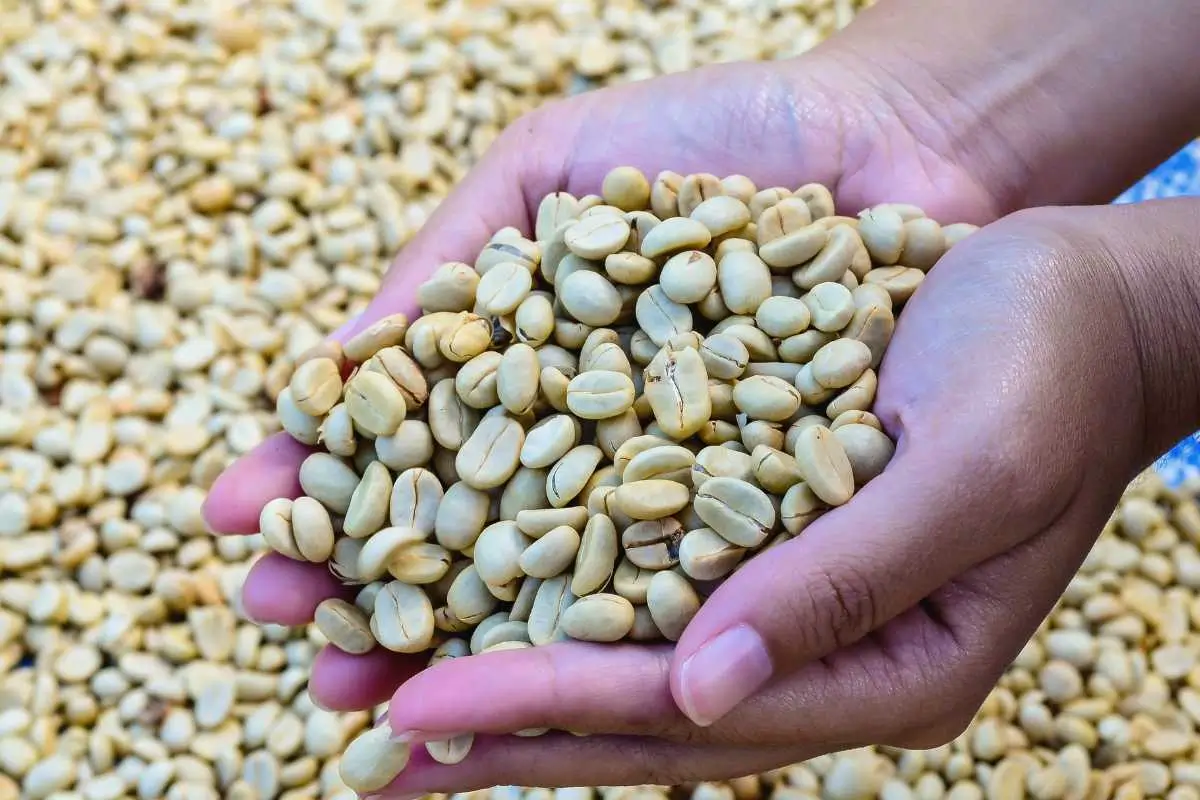The best green coffee beans for espresso typically have a balanced acidity and full body, such as those from Brazil or Colombia. For an exceptional espresso, consider single-origin beans with a smooth, chocolatey profile.
Espresso aficionados often seek the perfect green coffee bean to roast for their daily ritual. The quest for the ideal espresso experience starts with selecting high-quality green beans known for their robust flavor and consistent quality. Brazil and Colombia are renowned for producing beans that meet these criteria, offering a rich and smooth taste that forms the foundation of a superior espresso.
When choosing green coffee beans, look for those with a reputation for delivering the full-bodied taste and aromatic presence espresso lovers crave. With the right beans, enthusiasts can roast them to their preference, ensuring each cup of espresso is fresh and flavorful. Remember, the journey to an impeccable espresso shot begins with the bean, and choosing wisely will elevate your coffee experience.
Introduction To Green Coffee Beans
Green coffee beans are the raw, unroasted seeds of coffee fruits. Before coffee reaches your cup, it starts as these earthy, fresh beans. They hold a treasure of flavors and possibilities, especially for espresso enthusiasts.
What Are Green Coffee Beans?
Untouched by heat, green coffee beans are the purest form of coffee beans. They are packed with natural compounds, offering a different experience than roasted coffee. Rich in antioxidants, these beans have a mild, clean taste.
Why Choose Green Coffee For Espresso?
- Freshness Control: Roast them to your preference.
- Health Benefits: Higher levels of chlorogenic acid.
- Unique Flavor Profile: Earthy and herbal nuances.
Key Factors In Selecting Best Green Coffee Beans for Espresso
Choosing the right green coffee beans is essential for crafting the perfect espresso. Key factors such as origin, freshness, and varietal can greatly influence the final taste. Understanding these elements will help you select the best beans for a rich and satisfying espresso experience.
Bean Origin And Its Impact On Flavor
Bean origin is crucial in determining the flavor profile of your espresso. Different regions impart unique characteristics:
- African beans often present floral and fruity notes.
- Latin American beans tend to offer a balanced, nutty taste.
- Asian beans are known for their full-bodied earthiness.
Consider the region’s climate, altitude, and soil to understand the bean’s inherent flavors.
Importance Of Bean Freshness
Freshness is vital for espresso. Fresh green beans ensure the best possible flavor after roasting. Look for suppliers who offer:
- Recent harvest dates
- Proper storage conditions
- Fast turnover rates
These factors guarantee beans that have preserved their natural oils and aromas.
Varietal Differences
Green coffee bean varietals differ in taste, size, and shape. Common varietals include:
| Varietal | Flavor Notes |
|---|---|
| Arabica | Sweet and complex |
| Robusta | Strong and bold |
Select a variety that aligns with your flavor preferences and espresso goals.
Top Green Coffee Bean Varieties For Espresso
Espresso lovers know the key to a perfect shot starts with the beans. Selecting the right green coffee beans for espresso can transform your morning ritual into a sublime experience. Let’s dive into the top varieties that are sure to elevate your espresso game.
Arabica Vs. Robusta: Which Is Best?
Arabica and Robusta beans are the most popular choices for espresso. Arabica beans are known for their sweet, soft taste and higher acidity. They often have chocolate and fruit undertones, making them a favorite among coffee aficionados. In contrast, Robusta beans pack a punch with their strong, harsh flavor and creamy texture when brewed. They also contain more caffeine and are less acidic, which can be perfect for those who want a serious wake-up call.
Popular Varieties From Around The World
- Colombian Supremo: Known for its balance and mild flavor, it’s an excellent choice for a smooth espresso.
- Ethiopian Yirgacheffe: Offers floral and fruity notes, ideal for those who enjoy complex flavors.
- Brazilian Bourbon: Features a chocolatey richness perfect for a classic espresso taste.
- Sumatra Mandheling: Delivers an earthy and herbal profile, standing out in espresso blends.
- Guatemalan Antigua: Provides a full-bodied experience with spicy and chocolate notes.
Each of these varieties brings a unique flavor profile to your espresso. By experimenting with different green coffee beans, you’ll discover the diverse tastes that the world of coffee has to offer. Embrace the journey to find your perfect espresso blend.

Processing Methods And Their Effects
Discover how the journey of green coffee beans shapes the espresso in your cup. The magic starts long before the grind. Different processing methods play a critical role in the final flavor profile of your espresso. Let’s explore these methods and understand their impact on your favorite brew.
Wet Vs. Dry Processing
Wet and dry processing are two paths that coffee beans can take after being harvested. Each method imparts distinct characteristics to the beans, influencing the taste of your espresso.
- Wet Processing – Also known as washed processing, involves removing the coffee cherry’s outer skin and pulp. The beans are then fermented in water to remove the mucilage. This method highlights the bean’s intrinsic acidity and offers a cleaner, more refined flavor.
- Dry Processing – Also referred to as natural processing, is the oldest method where whole cherries are dried in the sun. Beans processed this way often have a fuller body and exhibit sweeter, fruitier notes.
Differences between the two methods are significant:
| Processing Method | Acidity | Body | Flavor Notes |
|---|---|---|---|
| Wet | Higher | Lighter | Clean and Refined |
| Dry | Lower | Fuller | Sweet and Fruity |
How Processing Influences Espresso Quality
The processing method not only affects the flavor but also the quality of the espresso. It’s a crucial factor that determines the bean’s development during roasting and its performance under pressure.
Wet-processed beans tend to have a more consistent size and density, leading to an even extraction. This uniformity is essential for a balanced espresso shot.
On the other hand, dry-processed beans may require careful roasting to bring out their complex flavors without overshadowing the espresso’s inherent qualities.
Understanding these nuances helps in selecting the best green coffee beans for espresso, tailored to personal taste preferences and desired flavor profiles.
Roasting Green Coffee Beans For Espresso
Espresso lovers know the secret to a perfect cup lies in the roast of the bean. Roasting green coffee beans for espresso transforms them from raw, grassy seeds into rich, aromatic gems. The roasting process is both an art and a science, crucial for unlocking the full potential of the coffee bean’s flavor.
Roasting Techniques
There is more than one way to roast a bean. Each technique affects the taste. It is important to choose the right method for espresso. Here are some popular methods:
- Air Roasting: Hot air roasts the beans evenly. It is quick and clean.
- Drum Roasting: Beans roast inside a rotating drum. It is traditional and common.
- Pan Roasting: Beans are roasted in a pan over a heat source. It is simple but requires constant attention.
Achieving The Perfect Espresso Roast
Creating the perfect espresso roast is about balance. The goal is to hit the sweet spot. It should be dark enough to be bold but not burnt. Here are steps to ensure the best roast:
- Choose High-Quality Beans: Start with the best green coffee beans you can find.
- Monitor the Temperature: Keep the heat steady. Too hot or too cold can spoil the beans.
- Listen for the Cracks: Beans make a ‘crack’ sound as they roast. The ‘second crack’ indicates a medium to dark roast perfect for espresso.
- Cool Them Quickly: Once roasted, cool the beans fast to stop the process.
- Rest the Beans: Let them rest. It allows the flavors to develop before grinding.
Remember, practice makes perfect. Roasting beans at home can be rewarding. It allows for a custom brew that suits your palate.
Grinding And Brewing Green Coffee
Discovering the right method for grinding and brewing green coffee opens a new dimension to espresso. Unlike roasted beans, green coffee beans require specific treatment. This section delves into how to transform green coffee into a delectable espresso shot.
Optimal Grinding Techniques
Grinding green coffee demands precision. Follow these steps:
- Use a high-quality burr grinder for consistent size.
- Grind beans to a fine consistency, similar to table salt.
- Ensure the grinder is clean to avoid flavor contamination.
- Grind immediately before brewing to maintain freshness.
Remember, the right grind size ensures even extraction and a balanced espresso.
Espresso Extraction Tips
Mastering espresso extraction is key. Consider these tips:
- Preheat your espresso machine to stabilize the temperature.
- Use filtered water to enhance the green coffee’s natural flavors.
- Dose correctly, typically 18-20 grams for a double shot.
- Tamp evenly to prevent water from channeling through the grounds.
- Time the shot for 25-30 seconds for optimal extraction.
With practice, you’ll craft the perfect green coffee espresso shot.
Taste Profiles Of Top Picks
Exploring the taste profiles of top picks for green coffee beans intended for espresso reveals a fascinating world of flavors. Each variety offers unique notes that can drastically enhance your coffee experience.
Flavor Notes To Look For
Identifying the right flavor notes is key to selecting the best green coffee beans for espresso. Here are some important flavors to consider:
- Brightness – Look for a lively, acidic note that adds freshness.
- Sweetness – Essential for balancing acidity and bitterness.
- Body – A fuller body gives a satisfying mouthfeel.
- Finish – Desirable beans have a clean and pleasant aftertaste.
Comparing Profiles Of Different Beans
Different green coffee beans bring diverse profiles to the table. Here’s a comparison:
| Bean Origin | Acidity | Sweetness | Body | Finish |
|---|---|---|---|---|
| Colombian Supremo | Medium | High | Medium | Smooth |
| Ethiopian Yirgacheffe | High | Medium | Light | Complex |
| Brazilian Cerrado | Low | Medium | Full | Rich |
This table helps to visually compare what each bean offers. Choose based on your flavor preference.
Where To Buy Quality Green Coffee Beans
Finding quality green coffee beans for espresso can be thrilling. These beans will transform your coffee experience. This guide will help you discover where to buy the best green coffee beans.
Trusted Suppliers And Retailers
Selecting the right supplier is crucial. Here are some top choices:
- Sweet Maria’s: A popular choice for home roasters.
- Burman Coffee Traders: Known for their variety and quality.
- Green Coffee Importers: They offer beans from around the world.
These suppliers guarantee freshness and quality. They provide detailed information about the origin and characteristics of their beans.
Online Vs. Local: Pros And Cons
| Buying Method | Pros | Cons |
|---|---|---|
| Online | More options, convenience | Can’t inspect beans before buying |
| Local | Inspect quality, support local businesses | Fewer options |
Buying online offers more variety and convenience. Buying local lets you check the beans’ quality and support local roasters. Both methods have their unique benefits and drawbacks.
Diy Tips For Home Roasters
DIY Tips for Home Roasters are essential for coffee enthusiasts looking to master the art of roasting green coffee beans for that perfect espresso. With the right tips and tricks, you can transform your kitchen into a mini coffee roastery. Let’s dive into how you can get started and avoid common pitfalls.
Getting Started With Home Roasting
Embarking on your home roasting journey unlocks a world of flavor possibilities. The first step is choosing high-quality green coffee beans.
- Opt for beans with a high density and good moisture content.
- Invest in a reliable roasting machine or use a simple popcorn popper.
- Ensure you have a well-ventilated space for roasting.
- Start with small batches to test different roasting times and temperatures.
Common Pitfalls To Avoid
Home roasting has its challenges. Stay alert and steer clear of mistakes.
| Pitfall | Tip |
|---|---|
| Over-roasting | Keep a close watch and smell the beans for signs of readiness. |
| Under-roasting | Understand the first and second ‘crack’ stages. |
| Inconsistent Bean Size | Sort beans before roasting for an even roast. |
| Poor Ventilation | Roast near a window or use a stove hood. |
Frequently Asked Questions
Can You Make Espresso With Green Coffee Beans?
No, you cannot make espresso with green coffee beans. Espresso requires roasted beans to achieve its characteristic flavor and aroma.
Which Coffee Beans Are The Best For Espresso Machine?
Arabica beans are widely favored for espresso machines, offering a smoother, sweeter taste. Dark roasts provide a bold flavor and are optimal for a rich espresso. Choose freshly roasted beans for the best experience.
What Coffee Is Best For Espresso Shots?
For espresso shots, a dark roast coffee often yields the best results due to its rich, robust flavor. Arabica beans are widely preferred for their superior taste and quality.
Are There Special Coffee Beans For Espresso?
Espresso is typically made with finely ground coffee beans known for their rich flavor and aroma. While no special beans are required, many prefer a dark roast for its robust profile.
Conclusion
Selecting the perfect green coffee beans for your espresso can transform your brewing experience. With the choices outlined, you’re equipped to make an informed decision. Remember, freshness and quality are key to a rich and robust espresso. Start your journey to exceptional home-brewed espresso today, one bean at a time.
Cheers to your next cup!


